Varieties and varieties of barberry

Barberry is one of the most popular shrubs in landscape design.... The huge variety of varieties and varieties of this plant opens up wide opportunities for using the culture in gardening. These plants can be planted singly, as a composition, and even as a hedge.



Description
In the wild, barberry lives in almost all regions of the Northern Hemisphere, with the exception of permafrost lands. As a decorative culture, it is planted everywhere in the Far East, Europe, as well as in Japan, China, in the Caucasus, in the Siberian region and in the Crimea.
Barberry is thorny shrub with alternate leaves... The thorns of this shrub are nothing more than modified leaf plates. From them only the middle vein remains, which becomes a thorn. In the axils of the leaves, short shoots are formed, due to which the leaves grow in dense bunches. The color of the leaf plates can be purple, yellow-lemon, scarlet, orange and even variegated.
Almost all varieties of barberry have a very exotic appearance, therefore they are used as hedges, in group or single plantings. Low varieties are popular when arranging alpine slides.



Barberries bloom beautifully, their small flowers resemble spherical bells in their appearance and literally shower the branches from mid-May... Most often, the color of the buds is yellow, but it can be orange with the inclusion of scarlet shades. The fruits have a wide variety of shapes and colors.
This shrub is distinguished by its unpretentiousness.... It can easily withstand the temperature fluctuations typical of temperate latitudes. Heat is not a serious problem for barberry, however, some varieties have to be covered for the winter.
This plant grows well and develops even in the poorest soils... The root system is underdeveloped - thanks to this feature, the plant easily gets along with the rest of the flora.



In fact, the only environmental requirements for barberries are the absence of any stagnation of water in the ground and abundant light. This crop is much easier to withstand prolonged drought than excess moisture. It can grow in shady places, but in this case, the color of the leaf plates will not be so bright, and fruiting will be rare.
Today botanists there are about 600 varieties of barberry, and most of them are planted for decorative purposes - this includes both dwarf varieties and gigantic ones. Each species is subdivided into separate varieties, which greatly increases the number of variations of this unusual shrub.
Let us dwell in more detail on the description of the most common varieties of barberry suitable for cultivation in our country.


Some are grown for aesthetic purposes, others for pharmacological purposes, and the fruits of the third can even be consumed as a food product.

Edible species
Some varieties of barberry bear fruit with delicious edible berries. Their fruits have a piquant sour taste, therefore, they are mainly used as spices, they are used to make jam, and also prepare compotes and jams. Berries are rich in ascorbic acid and are especially useful during the cold season.
Edible barberries usually give a fairly bountiful harvest - up to 10-15 kg of berries can be harvested from one bush. At the same time, the decorative qualities of the plant at all stages of its development are exceptionally high, so the plant becomes a real decoration of the site.


Amur barberry
Quite a large bush, the height of which reaches 2-3 m, the crown is very spreading. The leaves grow up to 8 cm, their color changes from month to month: in warm seasons it has a deep green tint, and in autumn it turns into orange.
Amur barberry usually blooms in May, inflorescences include 20-25 small yellow flowers. The first flowering of the culture occurs already in the first season, but this barberry begins to bear fruit only at 4 years old. The berries ripen by November. They are quite large - up to 1 cm, have a rich red hue.
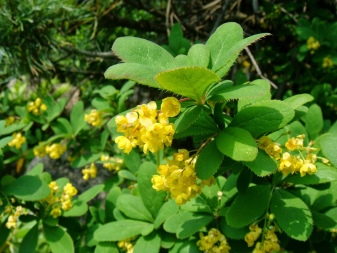
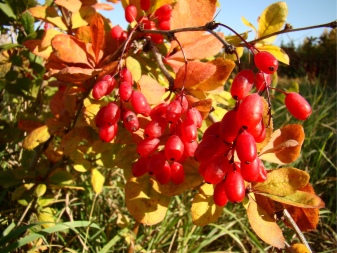
Amur barberry in the gardens of our compatriots is represented by two main varieties.
- "Yaponika" - a beautiful bush with rather wide oval leaves and yellow flowers in the form of drooping brushes.
- "Orpheus" - is a selective form of edible barberry, bred specifically for decorating the site. Forms a small bush no more than 1 m in height, does not bloom and does not form fruit.


Common barberry
Another edible variety that grows naturally in the Caucasus and southern Europe. Thanks to the efforts of scientists, varieties that are resistant to low temperatures have been developed. Such varieties are capable of successfully grow and develop even in Siberia.
The height of such a barberry is 2.5 m, the shoots diverge in arcs in different directions and form a large crown. Leaves of dark green color with a slight bluish bloom. Branches are thorny, yellowish-brown.

Flowering occurs in late May - early June. The inflorescences are racemose, exude a sweetish aroma, which attracts a large number of bees and other insects. The flowers stay on the bush for quite a long time, preserving its spectacular appearance.
The plant is not particularly demanding on the quality of the soil. However, when placed in shady wetlands, it stops growing.

The most common varieties of common barberry include several varieties.
- "Aureomarginata" - this bush grows up to 2.5-3 m in height, it is distinguished by decorative foliage with a yellow edging. The berries are sweet and sour, fully ripen in early October.
- "Lutea" - this shrub grows no more than 2 meters, the leaves are red, and the branches are purple. The berries begin to ripen at the beginning of autumn.
- "Atropurpurea" - the height of this barberry does not exceed 1.5 m. The leaves are maroon, the shoots are deep purple. The fruits finally ripen in September.
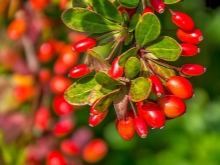


Black barberry
The homeland of this bush is Asia. The plant is thermophilic, so it needs wrapping for the winter. It grows up to 2 m, has red branches and dark green leaves. Flowering most often occurs at the beginning of summer, the inflorescences are yellow-pink, fragrant. This type of barberry received its unusual name for the spherical berries of dark blue, almost black color, on top of the berries are covered with a light bluish bloom.
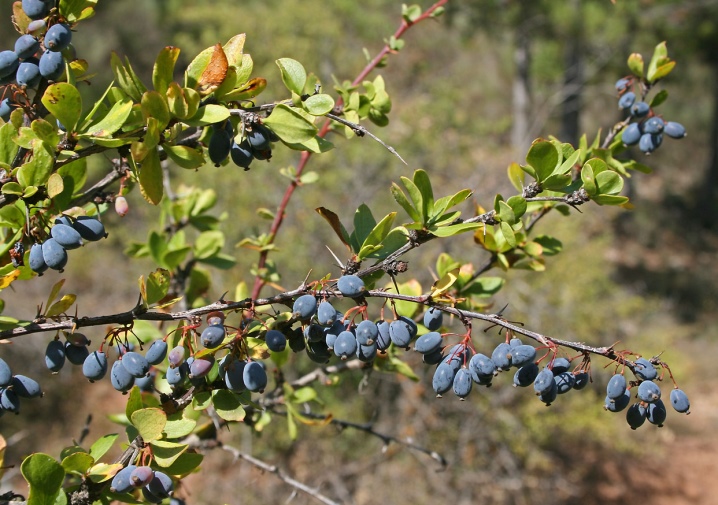
Tibetan
This barberry lives mainly in North India, East China, and also in the mountains of Tibet. This plant is rightfully considered one of the most useful varieties of barberries - the healing power of red fruits is widely used in alternative medicine.
The shrub grows up to 3.5 m, the branches grow upward and on the sides. The leaves are deep green, the color of the flowers is atypical for barberries - dark purple.

Goji Shambhala
A thorny shrub that grows up to 3-3.5 m. It is famous all over the world for its Goji berries, which are credited with truly miraculous properties. It is believed that these fruits are able to alleviate the condition of cancer and many other diseases.
Important: the use of barberry berries for medical purposes is possible only after consulting your doctor.
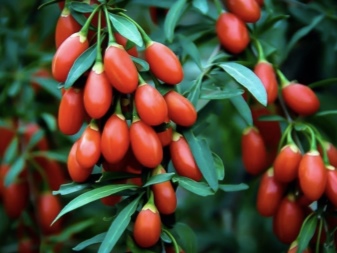

Decorative deciduous varieties
Barberry is highly valued for its decorative qualities, thanks to which the culture is widely used in gardening, as well as in the arrangement of parks, squares and gardens. Among the most "colorful" varieties, several species and varieties can be distinguished.
Orange Dream
Columnar barberry, the length of which reaches 1.5 m in height, and in width - only 40 cm. The plant has a slow growth rate.
Foliage in the spring-summer period is yellowish-orange with a slight pinkish tint. With the onset of cold weather, she changes her color scheme to orange-purple.
The culture prefers well-lit areas, tolerates heat well, does not tolerate waterlogging, and requires annual pruning to form a beautiful crown.
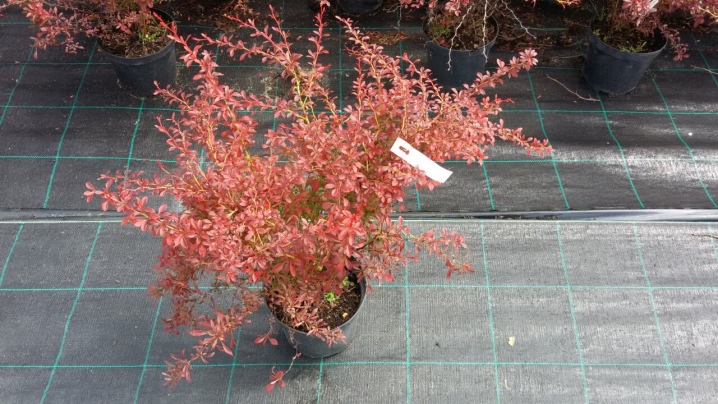
Golden Torch
Another slow-growing columnar variety. The color of the leaves also depends on the season: in the spring it is orange, in the summer it is deep yellow, and in September it gradually changes its ebb to red. Inflorescences are small, reddish yellow. The fruits ripen in autumn and stay on the branches until the first frost.

Canadian
This variety of barberry has a spreading crown. The color of the foliage varies, ranging from deep purple to bright scarlet.
In Russia, the Canadian barberry is not widely used, it is cultivated mainly in the Urals and in the regions of Siberia.
Let's list the most popular varieties of this barberry.
- "Superba" - a spectacular shrub, purple shoots, yellow crown, and bright red leaves. It is characterized by a high growth rate and requires regular molding.
- "Auricoma" - a shrub with spectacular burgundy leaves.
- Silver Miles - a medium-sized variety up to 2.5-3 m high, the color of the leaf plates varies from purple to pink. The flowers are rather small, but abundant, reddish-yellow.


Decorative foliage varieties Silver miles, Coral, Frikarta, Bonanza Gold, and Green Ornament are very popular among gardeners.


Dwarf shrubs
Low-growing varieties of barberry are very popular in gardening for decorating hedges. Such dwarfs develop rather slowly, while growing compactly, take up little space and practically do not require pruning - their beautiful crown is formed independently.
Bagatelle
A spectacular shrub with a rounded shape. Height of adult specimens is not more than 40 cm both in width and height. The leaves are small, no more than 1 cm, the color is bright purple.
Inflorescences are small, pale yellow. The fruits ripen by the beginning of October, they are edible, so they can be used in cooking. This barberry is not afraid of the summer heat, but in Siberian regions with severe winters it requires a mandatory shelter for the winter.

Atropurpurea Nana
A beautiful red-leaved variety. Annual growth is no more than 10-15 cm, on poor soils, the growth rate is even lower. The crown is round, mature plants rarely exceed 50 cm in length and 1 m in width.
The leaf plates are small, in the warm season they are painted in purple, in autumn scarlet colors become predominant.
Barberry blooms for about 10-14 days, the flower is scarlet outside and yellow inside. The berries ripen at the end of September and have a glossy red color.
The plant prefers lighted places, in shady plantings it stops in growth and development. It is not particularly demanding for watering, but reacts unfavorably to stagnant moisture.

Kobold
A low-growing plant with a height of only 50 cm. Shoots are red-brown in color, starting to grow in April. The leaves are small, up to 1.5 cm, the shape is spherical. In springtime, the foliage is bright green, but as the temperature drops, it begins to fade and gradually turns yellow.
Flowering begins in early May, blooms with rather beautiful yellow flowers with a reddish rim. Fruits are dark pink, almost red, can be eaten.
This barberry tolerates heat and short-term drought well, it is not afraid of air pollution.It can fully develop both in the sun and in a shady place.

Other varieties
Let us dwell in more detail on other common varieties and varieties of this plant.
Evergreen
Barberries that retain their green appearance throughout the year are highly prized in garden design.... You can decorate your personal plot not only with cypresses, pines and thujas - evergreen barberries can be a good alternative to them. The varietal variety of these representatives of the family is great, all of its varieties differ in their shape, dimensions, subtleties of care, as well as resistance to low temperatures and reaction to gassed air.
Such barberries are usually prickly, but they form a spectacular hedge. All varieties tolerate a haircut without problems and therefore allow you to create rather interesting landscape compositions.

Barberry Darwin
This shrub is 1.5-2 m high. It grows slowly and is grown only for decoration. The foliage is green, shiny, there is a small thorn at the tip of the leaf plates.
Darwin's barberry blooms with yellowish-orange flowers, the berries are black with a pronounced bluish bloom, ripen by the end of September.
The bush has good winter hardiness, can withstand a drop in temperature to -10 ... 15 ° C, therefore, it is mainly bred in the south of our country.

Barberry Ganepena
One of the slowest growing plants, which reaches only 2 meters by the age of 8-10. The shoots are curved, covered with pointed thorns of 1.5-2 cm.
Blooms in May, inflorescences are light yellow, very fragrant. In mid-September, black fruits with a grayish coating ripen on the branches. They are inedible, therefore they are suitable exclusively for landscape design.
Among all barberries of this species, the most widespread variety is Klugovski, obtained by German botanists. It is distinguished by unpretentiousness, low demands on the substrate and resistance to low temperatures. The plant easily tolerates the most polluted air, due to which it is widely used in urban gardening.

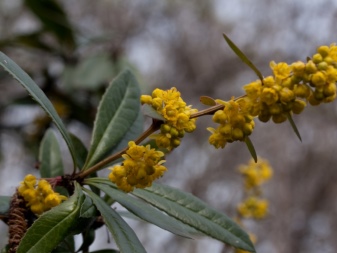
Juliana's barberry
This plant grows up to 2 m in height and up to 4 m in width. The leaf plates are quite large - 10 cm, thorns are formed at the ends. Young leaves have a bronze tint, while adults are dark green.
Flowering usually begins in the last decade of May - early June. The flowers are yellow with a reddish-orange edging, collected in spectacular inflorescences. The berries ripen in September, have a dark blue, almost black hue.
This type of barberry is decorative, therefore it is often used in landscaping gardens, parks and city squares.
It is noteworthy that the shrub is very unpretentious to care for and easily takes root in the most ecologically unfavorable regions.

Variegated
The design of any garden plot is unlikely to be complete without rich, bright colors, so breeders have bred variegated varieties of barberry. Their leaves are red, lemon and purple in color. They are commonly used in combination with green varieties and also as solitary tapeworms.
Admiration
A low shrub, the length of an adult plant does not exceed half a meter, while the annual growth is only 4 cm. The leaves are quite large - up to 3.5 cm, which is atypical for a dwarf. The decoration of this barberry is its entire red foliage with a thin border.
Flowering usually occurs at the end of spring, the berries finally ripen only in autumn. Such fruits are unsuitable for food, but their bright scarlet color decorates the site for a long time and pleases with its appearance.

Special Gold
Low-growing variety with a height of no more than 30 cm. The foliage is a rich yellow-lemon color.
This plant is classified as frost-resistant, it easily tolerates hot summer days and a short drought. It grows and develops best in illuminated areas, but can also thrive in shade.

Fast growing
Varieties of Thunberg barberry will help to create a hedge in the shortest possible time. They are distinguished by such features as:
- the height of the shrub is 2.5-3 m;
- thorns on branches;
- oblong leaves up to 3 cm long, in the warm season they are green, and in autumn they become scarlet;
- inflorescences are oblong, yellow, bloom for about 2 weeks;
- berries are large, elliptical.
The fruits do not fall off for a long time and are kept on the bushes for several months, they are not used for food.


Red chef
A beautiful shrub that attracts gardeners with its reddish-brown foliage and branches. The crown is funnel-shaped, the adult plant grows up to 2.5 m in height, the girth in width is about 1.5 m. All shoots are completely covered with pointed thorns.
Flowering begins in late May, fruit ripening usually occurs in October.
The variety easily tolerates cooling and polluted air. It grows and develops well in shading, as well as in bright sun.

Emerald
An upright barberry with a wide pyramidal crown. Shoots are covered with pointed thorns. The leaves are small, depending on the season, they change their color: in spring and summer they are green, and starting from September they gradually change the color to yellow.
The berries are deep red, elongated. They finally ripen at the end of October and do not fall off for a long time, they can even survive on the bushes until spring.

Examples in landscape design
Barberry in garden decor can be used in several ways.
High varieties are suitable for decorating hedges, undersized ones are mainly planted to decorate the borders of flower beds.

Thorny varieties are planted around the perimeter of the site - they scare away uninvited guests and thus perform a protective function.

Barberry varieties with a spectacular crown are suitable for decorating flower beds in a composition with other perennials. Varieties with red leaves look very beautiful. Red Carpet, Rosie Rocket, and Ruby Star.


The real decoration of the site will be barberry Juliana, pinkish-orange leaves of which are set off by deep blue berries. Varieties with bright yellow leaves, such as Summer Sunset and variegated varieties such as Cornic.

For rocky gardens and rockeries are used dwarf species - they blend harmoniously with large stones and brick walls.

Low-growing and boxwood varieties also suitable for growing in tubs and containers, and creeping - forms an exotic carpet on the site.

For the features of caring for barberry, see the next video.
































































The comment was sent successfully.